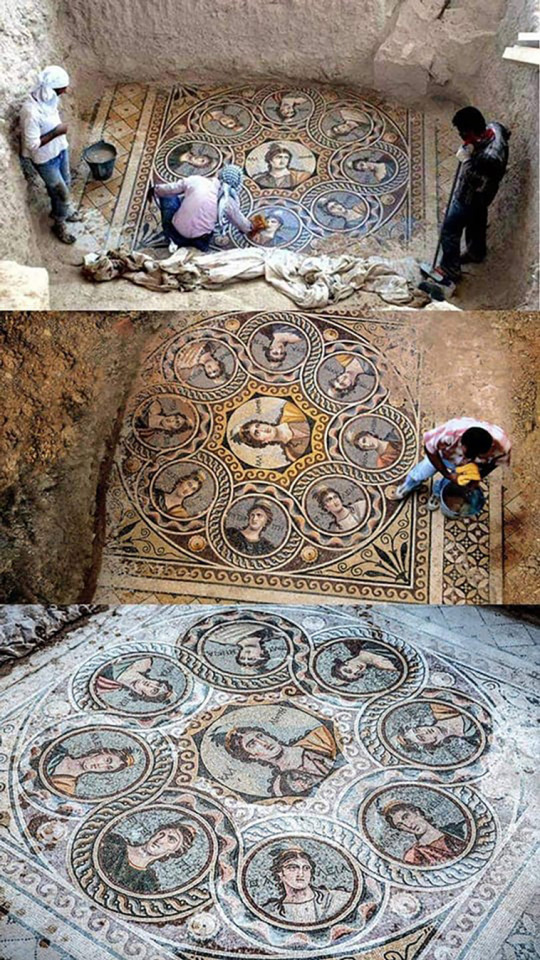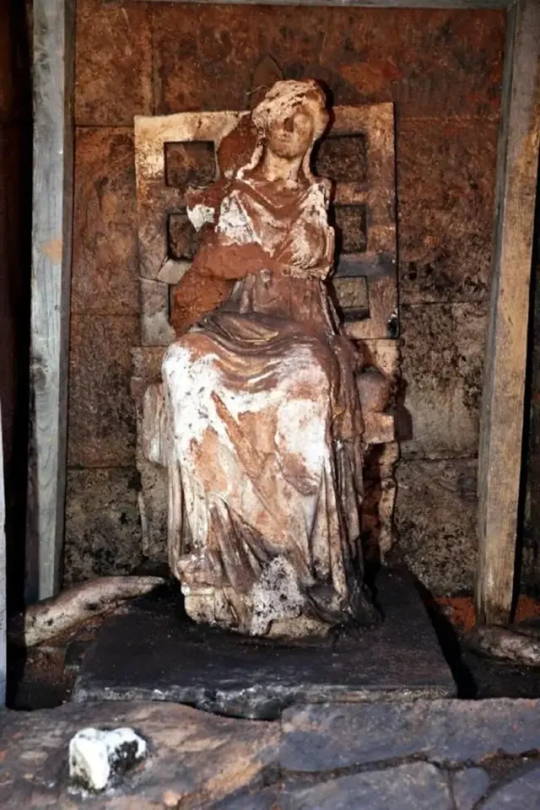#ancient turkey
Explore tagged Tumblr posts
Text
Nice that for once it isn't an economic document. Not so nice that it's about a catastrophe.
192 notes
·
View notes
Text

A well-preserved mosaic from the temple of Apollo
This mosaic is the original from the temple of Apollo at the Ancient Letoon, a religious Anatolian complex devoted to Leto and Her children - patron Gods of Lycia. Letoon is considered to have been around before the Hellenic influence in the region, though over time it has become a place of mixing of many cultures and eras.
The mosaic, for example, dates back to around 400 BCE when the temple to Apollo within the Letoon complex was built by King Erbinna, a Lycian ruler. The solar symbol in the middle is believed to symbolize Lycia, the land of the Sun. The quiver of arrows and the lyre are for Apollo as well.
Currently, the original is at the museum in Fethiye, Turkey. The mosaic presented at the site is a modern replica created after the original was removed.
Photo source: 🏺
#ANTIGÜEDADES 💎#ancient art#ancient anatolia#ancient lycia#ancient turkey#letoon#mosaic#apollo#greek mythology#anatolian gods#mediterranean gods
34 notes
·
View notes
Text

Stone carved Medusa from the Temple of Apollo at Didyma in Turkey.
#Stone carved Medusa from the Temple of Apollo at Didyma in Turkey#Temple of Apollo#Didyma Turkey#Medusa#stone statue#stone sculpture#ancient artifacts#archeology#archeolgst#history#history news#ancient history#ancient culture#ancient civilizations#greek history#greek art#ancient art
3K notes
·
View notes
Photo

Sacred Waters ✨️ Pamukkale's Limestone Basins
2K notes
·
View notes
Text



Cappadocia, Turkey by Caspar Tromp
#cappadocia#turkey#landscape photography#nature photography#street photography#film photography#35mm#architecture#ancient history#textiles#lensblr#curators on tumblr
2K notes
·
View notes
Text









December 2024. Day one in Turkey. The Library of Celsus! From the Ephesus Archaeological Site. Photos by me. More from Turkey here.
[Image descriptions: tourists visiting the ruins of the Library of Celsus. End description.]
#my photos#photography#travel#Europe#Asia#Turkey#kuşadası#ephesus#library of celsus#archaeology#ruins#Ancient Rome#Ancient Greece
238 notes
·
View notes
Photo

The nine muses of Ancient Greece discovered in the ancient Greek city of Zeugma, now in modern-day Turkey. The mosaics have been almost perfectly preserved for over 2,000 years
4K notes
·
View notes
Text

Library of Celsus in Ephesus, Anatolia, TÜRKIYE
#library#celsus#libreria#ancient#roman#building#edificio#romano#ancestral#ephesus#efesios#anatolia#türkiye#turkey#turquia#europe#europa#asia
284 notes
·
View notes
Text

Hetalia Exercise Doodles
#hetalia#aph turkey#aph ireland#aph ancients#aph south korea#hws turkey#hws ireland#hws ancients#hws south korea#art#digital art#artwork
178 notes
·
View notes
Text

Relief of the twelve Hittite gods of the underworld at Yazılıkaya Rock Temple, Türkiye.
#archeology#bronze age#ancient archeology#ancient#ancient history#ancient art#ancient sculpture#antiquité#antichità#anatolia#ancient anatolia#hittite#hittite empire#turkey#türkiye
57 notes
·
View notes
Text
What an incredible find! Not necessarily a new discovery, but one that now has additional evidence.
23 notes
·
View notes
Photo
Temple and sanctuary of Apollo in Didima, Turkey, one of the largest from the Hellenistic period. With a plan of 51m x 109m, it had 120 Ionic columns. The complex was a place as sacred as Delphi, it was never fully completed as it did not have a roof.

Majestic Place ♡
...ancient history
.



Didyma, Temple of Apollo
Photo credit: F. Tronchin
244 notes
·
View notes
Text

A 2,100-Year-Old Marble Statue of Mother Goddess Cybele Discovered in Turkey
An estimated 2,100-year-old rare marble statue of Cybele, the mother goddess of Anatolia, has been unearthed in excavations in northern Ordu province located on the Black Sea coast.
The historic sculpture of Cybele sitting on her throne weighed a whopping 200 kilograms and was about 110 centimeters tall.
The statue is also the first marble statue found in Turkey in its original place.
The ancient artifact was unearthed in excavations launched by a team of 25 archeologists led by the head of the Department of Archeology in Gazi University, Prof. Dr. Süleyman Yücel Şenyurt, in the 2,300-year-old Kurul Kalesi, or the Council Fortress.


"We are continuing our work non-stop. Two days ago we found an extraordinary artifact. According to our research, the statue remained intact after the walls of the entrance of the fortress of Kurul collapsed during an invasion by Roman soldiers. This statue has also shown us that the fortress of Kurul in Ordu was a very important settlement [in ancient times]," Prof. Şenyurt said.
Saying that it was an incredibly rare find, the professor said that they were proud to unearth such an artifact in Turkey. He also said that the priceless statue would be later on transferred to the archeology museum in Ordu.
The professor also said that the first attempts to conduct excavations in the area were made about 6 years ago, but had been postponed for various reasons.


Meanwhile, Mayor Enver Yılmaz also pledged to provide TL 500,000 in funds to all excavations in the fortress of Kurul. He also said that the fortress will be turned into an open air museum in the near future and hopes the excavations will contribute to tourism in the region as well as in Turkey.
The excavations in the fortress are also the first archaeological diggings on the eastern coast of the Black Sea.
Cybele, an Anatolian mother goddess, is the symbol of prosperity with her pregnant belly, seated on her throne.
In Anatolian mythology she was the personification of the earth. In Greek mythology in which she was equated to Earth-goddess Gaia, Cybele was mostly associated with fertile nature, mountains, town and city walls, as well as wild animals such as lions.

#A 2100-Year-Old Marble Statue of Mother Goddess Cybele Discovered in Turkey#fortress of Kurul#marble#marble statue#marble sculpture#the mother goddess of Anatolia#ancient artifacts#archeology#history#history news#ancient history#ancient culture#ancient civilizations#roman history#roman empire#ancient art
353 notes
·
View notes
Text

Byzantine marble mosaic, Bursa, Turkey
Caspar Tromp
717 notes
·
View notes
Text
Basilica Cistern, Istanbul, Turkey built in the year 532 during the reign of Justinian I. It supplied the city with water and is approx. 9800 m² of surface. It is capable of holding between 80,000 and 100,000 m³ of water.
1K notes
·
View notes
Text
person looking at any global or historical phenomanon: surely i can analyze this strictly through the united states' racial structures, right? right?
#mine*#b4 ppl call me slurs over this - i made this w both greece/turkey and the literal ancient roman empire in mind#also now that i think abt it thats how americans view antisemitism
400 notes
·
View notes